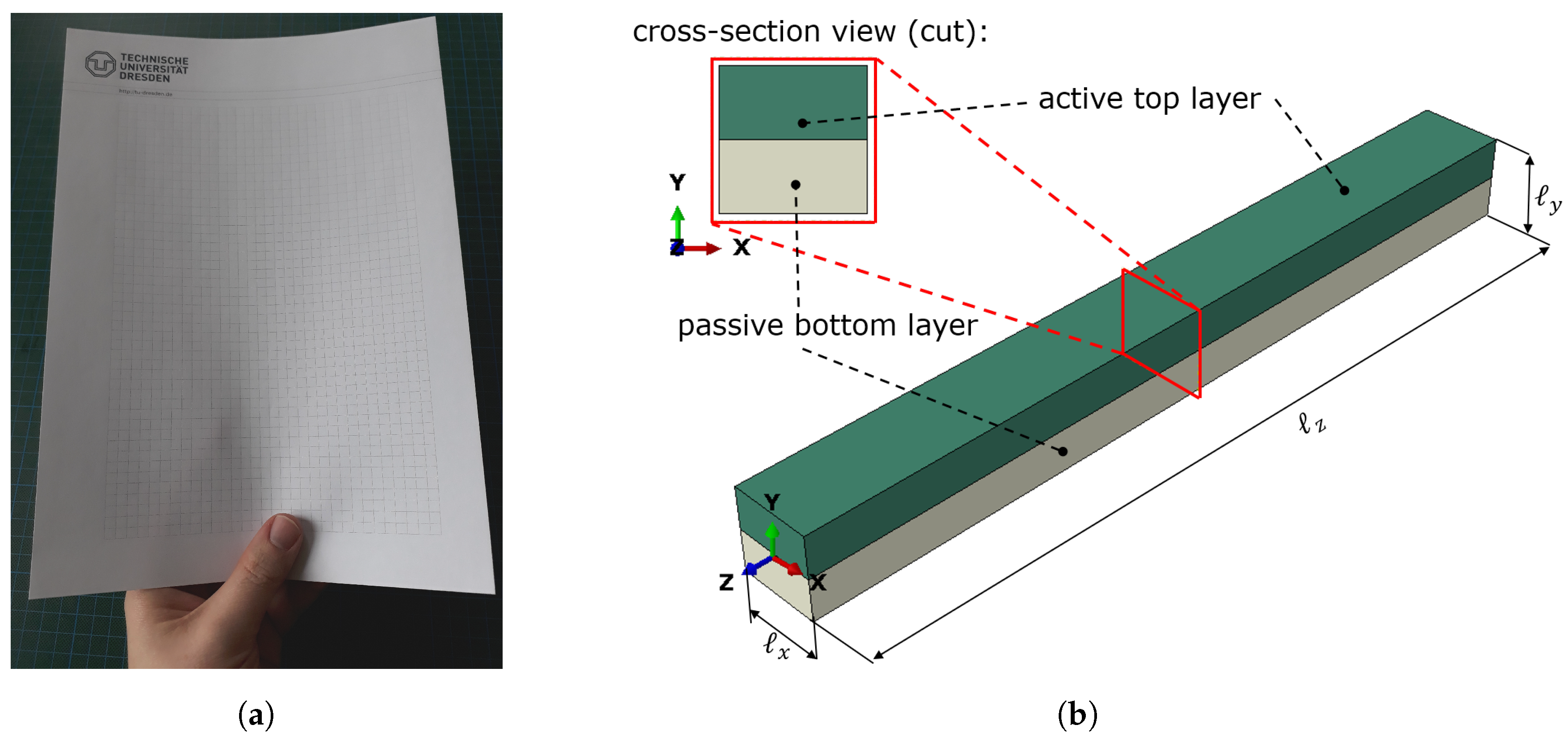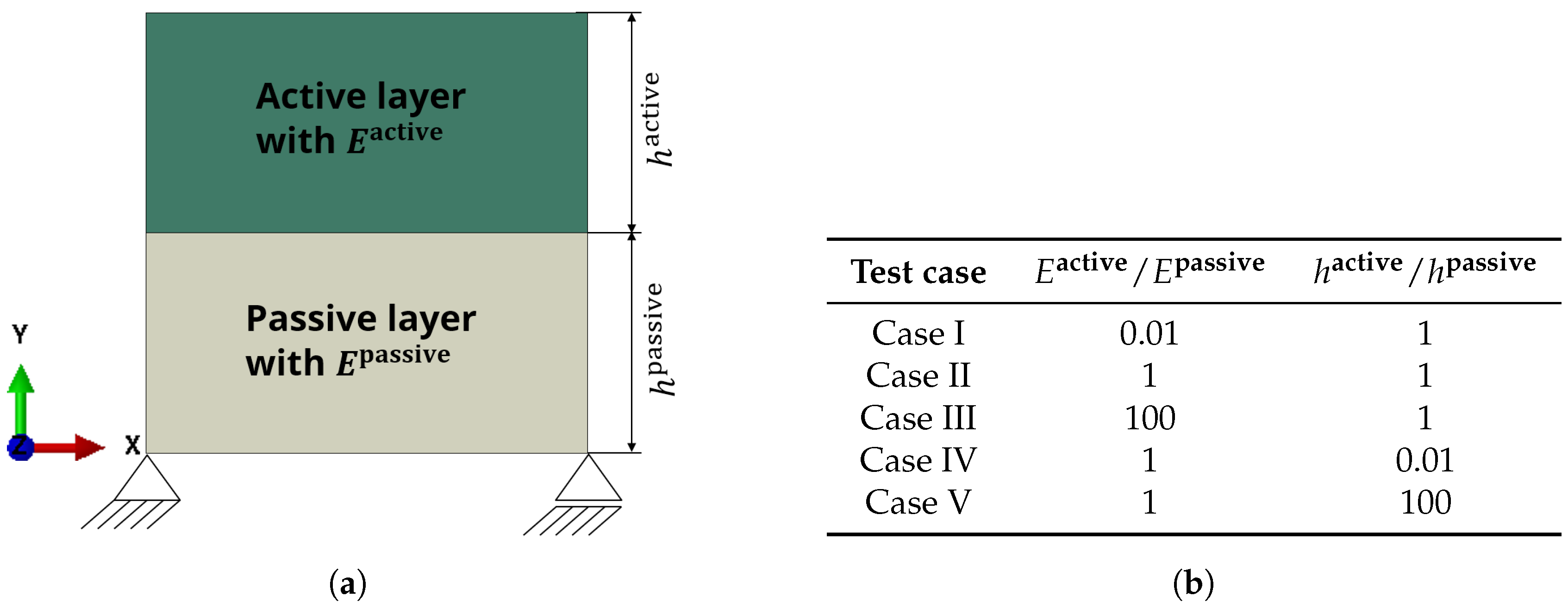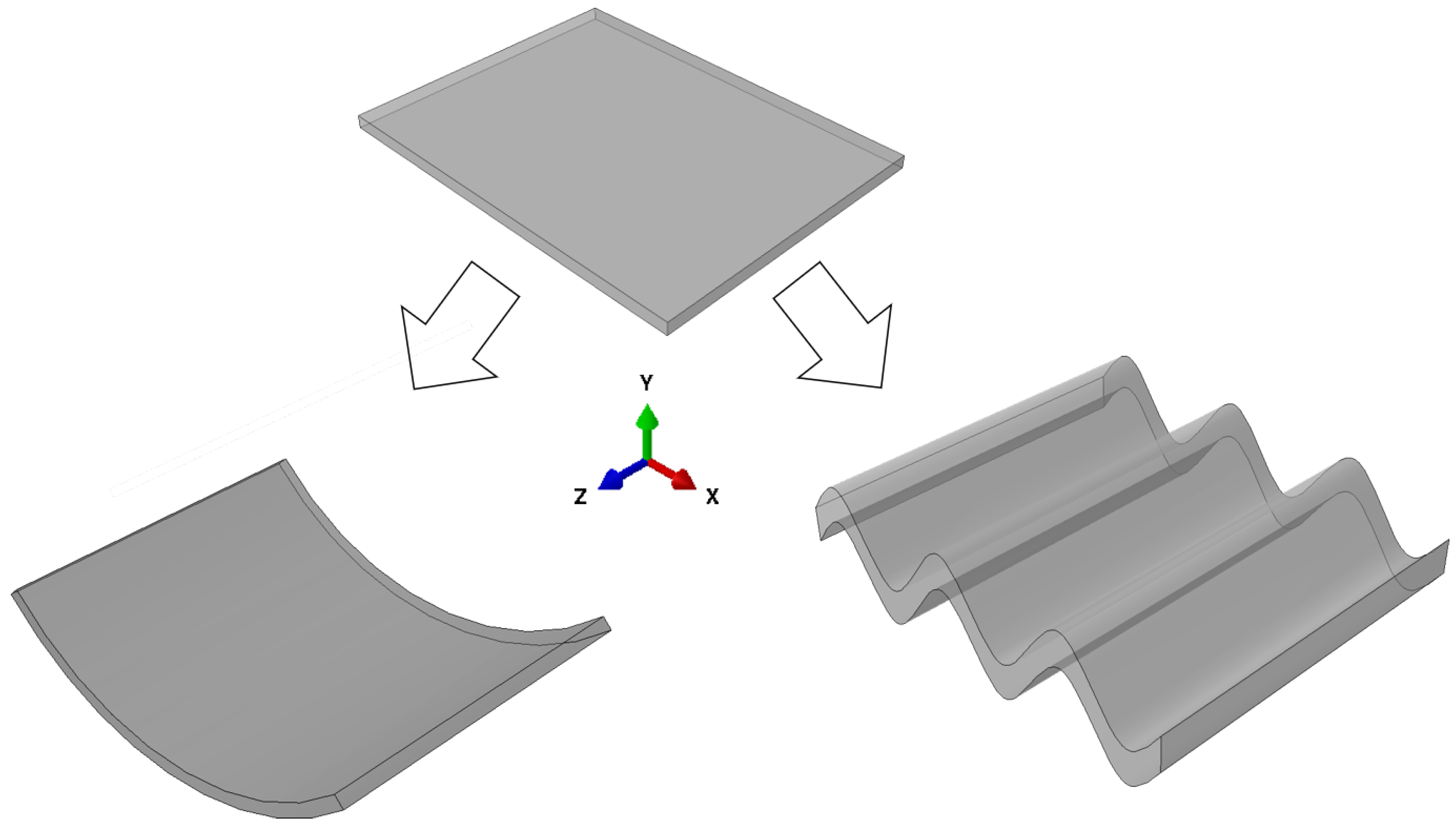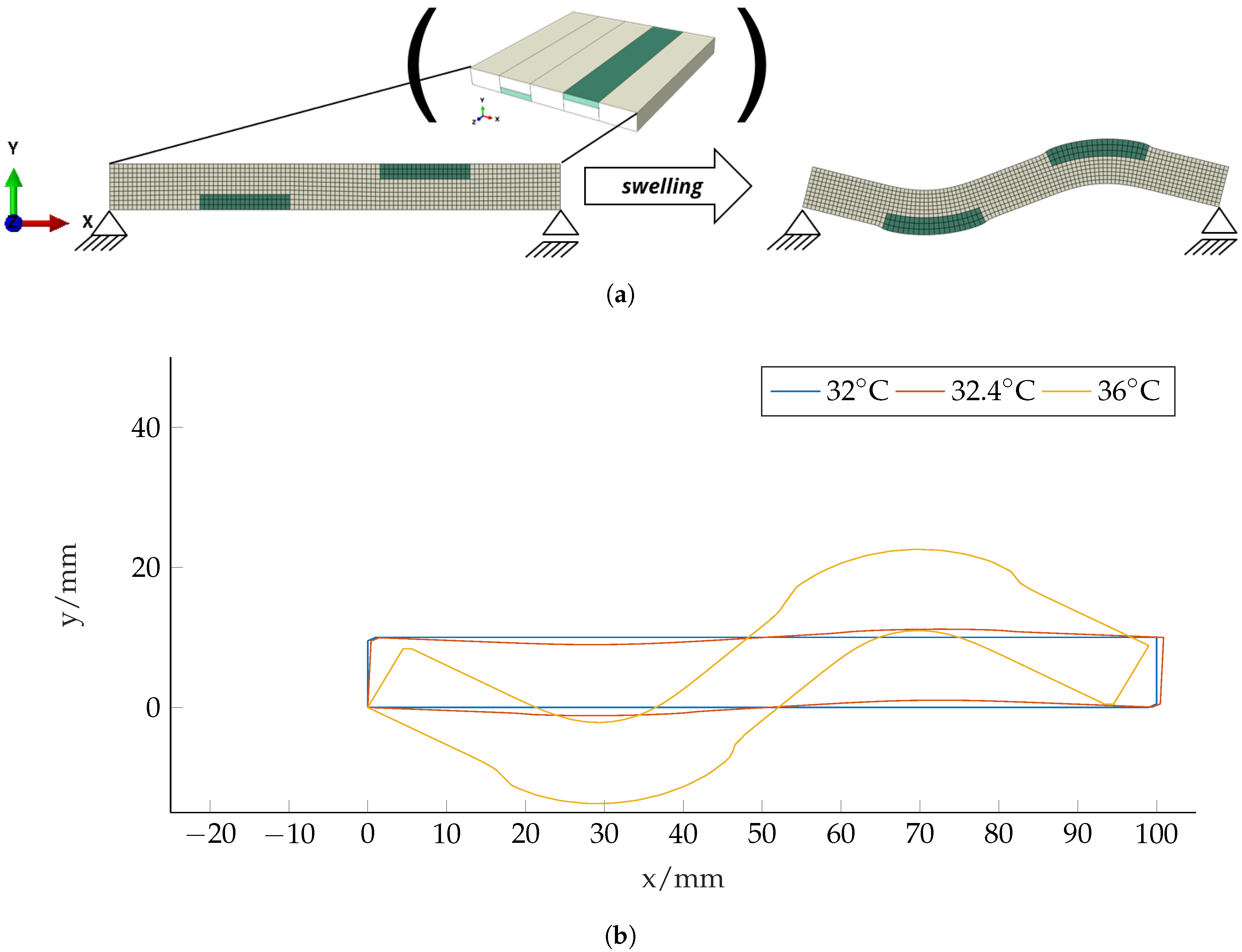Shell-Forming Stimulus-Active Hydrogel Composite Membranes: Concept and Modeling
Abstract
:1. Introduction to Hydrogel Composite Membranes and Shells
1.1. Active Hydrogel Composites
1.2. Passive Shells and Corrugated Sheets
2. Modeling of Composite Shells Using the Temperature-Expansion-Model
3. Simulation Results for Shell-Forming Hydrogel Composites and Active Corrugated Sheets
3.1. Simple Curved Beam-Like (U-forming) Structure
3.2. Active Corrugated Sheets
4. Conclusions and Outlook
Author Contributions
Funding
Conflicts of Interest
References
- Ehrenhofer, A.; Hahn, M.; Hofmann, M.; Wallmersperger, T. Mechanical Behavior and Pore Integration Density Optimization of Switchable Hydrogel Composite Membranes. J. Intell. Mater. Syst. Struct. 2020, 31, 425–435. [Google Scholar] [CrossRef]
- Gerlach, G.; Arndt, K.F. Hydrogel Sensors and Actuators: Engineering and Technology; Springer Science & Business Media: Berlin, Germany, 2009; Volume 6. [Google Scholar]
- Ehrenhofer, A.; Wallmersperger, T. Active hydrogel composite membranes for the analysis of cell size distributions. In Behavior and Mechanics of Multifunctional Materials XIII; Naguib, H.E., Ed.; International Society for Optics and Photonics: Bellingham, WA, USA, 2019; Volume 10968, pp. 279–286. [Google Scholar]
- Ehrenhofer, A.; Bingel, G.; Paschew, G.; Tietze, M.; Schröder, R.; Richter, A.; Wallmersperger, T. Permeation Control in Hydrogel-Layered Patterned PET Membranes with Defined Switchable Pore Geometry—Experiments and Numerical Simulation. Sens. Actuat. Chem. 2016, 232, 499–505. [Google Scholar] [CrossRef] [Green Version]
- Seok-Hyo, C.; Park, C. Rollable Display Device. U.S. Patent 9,098,241, 18 August 2016. [Google Scholar]
- Xu, Y.; Chen, J.; Zhang, H.; Wei, H.; Zhou, L.; Wang, Z.; Pan, Y.; Su, X.; Zhang, A.; Fu, J. White-light-emitting flexible display devices based on double network hydrogels crosslinked by YAG: Ce phosphors. J. Mater. Chem. C 2020, 8, 247–252. [Google Scholar] [CrossRef]
- Matysek, M.; Lotz, P.; Schlaak, H.F. Tactile display with dielectric multilayer elastomer actuators. In Electroactive Polymer Actuators and Devices (EAPAD) 2009; International Society for Optics and Photonics: Bellingham, WA, USA, 2009; Volume 7287, p. 72871D. [Google Scholar]
- Drzaic, P.; Comiskey, B.; Albert, J.; Zhang, L.; Loxley, A.; Feeney, R.; Jacobson, J. 44.3 L: A Printed and Rollable Bistable Electronic Display. In SID Symposium Digest of Technical Papers; Wiley: Hoboken, NJ, USA, 1998; Volume 29, pp. 1131–1134. [Google Scholar]
- Ehrenhofer, A.; Elstner, M.; Wallmersperger, T. Normalization of hydrogel swelling behavior for sensoric and actuatoric applications. Sens. Actuat. Chem. 2018, 255, 1343–1353. [Google Scholar] [CrossRef]
- Richter, A.; Wenzel, J.; Kretschmer, K. Mechanically adjustable chemostats based on stimuli-responsive polymers. Sens. Actuat. Chem. 2007, 125, 569–573. [Google Scholar] [CrossRef]
- Arndt, K.F.; Kuckling, D.; Richter, A. Application of sensitive hydrogels in flow control. Polym. Adv. Technol. 2000, 11, 496–505. [Google Scholar] [CrossRef]
- Binder, S.; Gerlach, G. Intramolecular force-compensated hydrogel-based sensors with reduced response times. Tm-Tech. Mess. 2019, 86, 227–236. [Google Scholar] [CrossRef]
- Richter, A.; Paschew, G.; Klatt, S.; Lienig, J.; Arndt, K.F.; Adler, H.J.P. Review on hydrogel-based pH sensors and microsensors. Sensors 2008, 8, 561–581. [Google Scholar] [CrossRef] [Green Version]
- Guelch, R.W.; Holdenried, J.; Weible, A.; Wallmersperger, T.; Kroeplin, B. Electrochemical stimulation and control of electroactive polymer gels. In Smart Structures and Materials 2001: Electroactive Polymer Actuators and Devices; International Society for Optics and Photonics: Bellingham, WA, USA, 2001; Volume 4329, pp. 328–334. [Google Scholar]
- Messing, R.; Schmidt, A.M. Perspectives for the mechanical manipulation of hybrid hydrogels. Polym. Chem. 2011, 2, 18–32. [Google Scholar] [CrossRef]
- Mau, B.; Erfkamp, J.; Guenther, M.; Wallmersperger, T. Experimental determination of material parameters for an enhanced modeling of polyelectrolyte gels. In Electroactive Polymer Actuators and Devices (EAPAD) XXI; International Society for Optics and Photonics: Bellingham, WA, USA, 2019; Volume 10966, p. 109661O. [Google Scholar]
- Skouri, R.; Schosseler, F.; Munch, J.; Candau, S. Swelling and elastic properties of polyelectrolyte gels. Macromolecules 1995, 28, 197–210. [Google Scholar] [CrossRef]
- Seuss, M.; Schmolke, W.; Drechsler, A.; Fery, A.; Seiffert, S. Core–Shell Microgels with Switchable Elasticity at Constant Interfacial Interaction. ACS Appl. Mater. Interfaces 2016, 8, 16317–16327. [Google Scholar] [CrossRef]
- Anseth, K.S.; Bowman, C.N.; Brannon-Peppas, L. Mechanical properties of hydrogels and their experimental determination. Biomaterials 1996, 17, 1647–1657. [Google Scholar] [CrossRef]
- Yuk, H.; Lin, S.; Ma, C.; Takaffoli, M.; Fang, N.X.; Zhao, X. Hydraulic hydrogel actuators and robots optically and sonically camouflaged in water. Nat. Commun. 2017, 8, 1–12. [Google Scholar] [CrossRef] [Green Version]
- Sun, J.Y.; Zhao, X.; Illeperuma, W.R.; Chaudhuri, O.; Oh, K.H.; Mooney, D.J.; Vlassak, J.J.; Suo, Z. Highly stretchable and tough hydrogels. Nature 2012, 489, 133–136. [Google Scholar] [CrossRef]
- Kang, M.K.; Huang, R. Swelling-induced instability of substrate-attached hydrogel lines. Int. J. Appl. Mech. 2011, 3, 219–233. [Google Scholar] [CrossRef]
- Senoussi, A.; Kashida, S.; Maitra, A.; Voituriez, R.; Galas, J.C.; Estevez-Torres, A. Tunable corrugated patterns in an active gel sheet. arXiv 2019, arXiv:1904.09249. [Google Scholar]
- Wallmersperger, T.; Wittel, F.K.; D’Ottavio, M.; Kröplin, B. Multiscale modeling of polymer gels—Chemo-electric model versus discrete element model. Mech. Adv. Mater. Struct. 2008, 15, 228–234. [Google Scholar] [CrossRef] [Green Version]
- Drozdov, A.; Sommer-Larsen, P.; Christiansen, J.d.; Sanporean, C.G. Time-dependent response of hydrogels under constrained swelling. J. Appl. Phys. 2014, 115, 233517. [Google Scholar] [CrossRef]
- Trinh, Q.T.; Gerlach, G.; Sorber, J.; Arndt, K.F. Hydrogel-based piezoresistive pH sensors: Design, simulation and output characteristics. Sens. Actuat. Chem. 2006, 117, 17–26. [Google Scholar] [CrossRef]
- Attaran, A.; Brummund, J.; Wallmersperger, T. Modeling and simulation of the bending behavior of electrically-stimulated cantilevered hydrogels. Smart Mater. Struct. 2015, 24, 035021. [Google Scholar] [CrossRef]
- Sobczyk, M.; Wallmersperger, T. Modeling and simulation of the electro-chemical behavior of chemically stimulated polyelectrolyte hydrogel layer composites. J. Intell. Mater. Syst. Struct. 2016, 27, 1725–1737. [Google Scholar] [CrossRef]
- Leichsenring, P.; Wallmersperger, T. Modelling and Simulation of the Chemically Induced Swelling Behavior of Anionic Polyelectrolyte Gels by applying the Theory of Porous Media. Smart Mater. Struct. 2017, 26, 035007. [Google Scholar] [CrossRef]
- Bluhm, J.; Serdas, S.; Schröder, J. Theoretical framework of modeling of ionic EAPs within the Theory of Porous Media. Arch. Appl. Mech. 2016, 86, 3–19. [Google Scholar] [CrossRef]
- Ehlers, W.; Acartürk, A.; Karajan, N. Advances in modelling saturated soft biological tissues and chemically active gels. Arch. Appl. Mech. 2010, 80, 467–478. [Google Scholar] [CrossRef]
- Acartürk, A.Y. Simulation of Charged Hydrated Porous Materials. Ph.D. Thesis, Universität Stuttgart, Stuttgart, Germany, 2009. [Google Scholar]
- Tibbitt, M.W.; Anseth, K.S. Hydrogels as extracellular matrix mimics for 3D cell culture. Biotechnol. Bioeng. 2009, 103, 655–663. [Google Scholar] [CrossRef] [Green Version]
- Caliari, S.R.; Burdick, J.A. A practical guide to hydrogels for cell culture. Nat. Methods 2016, 13, 405. [Google Scholar] [CrossRef] [Green Version]
- Binder, S.; Krause, A.T.; Voit, B.; Gerlach, G. Bisensitive hydrogel with volume compensation properties for force compensation sensors. IEEE Sensors Lett. 2017, 1, 1–4. [Google Scholar] [CrossRef]
- Reddy, J.N. Mechanics of Laminated Composite Plates and Shells: Theory and Analysis; CRC Press: Boca Raton, FL, USA, 2003. [Google Scholar]
- Flügge, W. Statik und Dynamik der Schalen; Springer: Berlin, Germany, 2013. [Google Scholar]
- Cai, S.; Suo, Z. Mechanics and chemical thermodynamics of phase transition in temperature-sensitive hydrogels. J. Mech. Phys. Solids 2011, 59, 2259–2278. [Google Scholar] [CrossRef]
- Ehrenhofer, A.; Wallmersperger, T.; Richter, A. Simulation of controllable permeation in PNIPAAm coated membranes. In SPIE 9800, Behavior and Mechanics of Multifunctional Materials and Composites 2016; SPIE: Bellingham, WA, USA, 2016; Volume 980016. [Google Scholar]
- Ehrenhofer, A.; Wallmersperger, T. Hydrogels for engineering: Normalization of swelling due to arbitrary stimulus. In SPIE 10163, Electroactive Polymer Actuators and Devices XIX; SPIE: Bellingham, WA, USA, 2017; Volume 10163, p. 1016321. [Google Scholar]
- Ehrenhofer, A.; Wallmersperger, T. A normalization concept for smart material actuation by the example of hydrogels. PAMM 2018, 18, e201800176. [Google Scholar] [CrossRef]
- Ehrenhofer, A.; Binder, S.; Gerlach, G.; Wallmersperger, T. Multisensitive Swelling of Hydrogels for Sensor and Actuator Design. Adv. Eng. Mater. 2020. in print. [Google Scholar]











© 2020 by the authors. Licensee MDPI, Basel, Switzerland. This article is an open access article distributed under the terms and conditions of the Creative Commons Attribution (CC BY) license (http://creativecommons.org/licenses/by/4.0/).
Share and Cite
Ehrenhofer, A.; Wallmersperger, T. Shell-Forming Stimulus-Active Hydrogel Composite Membranes: Concept and Modeling. Micromachines 2020, 11, 541. https://doi.org/10.3390/mi11060541
Ehrenhofer A, Wallmersperger T. Shell-Forming Stimulus-Active Hydrogel Composite Membranes: Concept and Modeling. Micromachines. 2020; 11(6):541. https://doi.org/10.3390/mi11060541
Chicago/Turabian StyleEhrenhofer, Adrian, and Thomas Wallmersperger. 2020. "Shell-Forming Stimulus-Active Hydrogel Composite Membranes: Concept and Modeling" Micromachines 11, no. 6: 541. https://doi.org/10.3390/mi11060541





